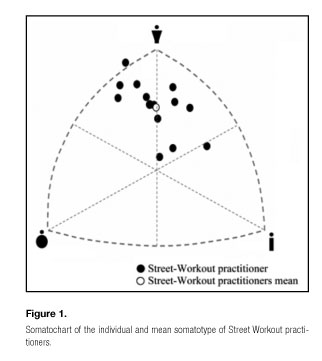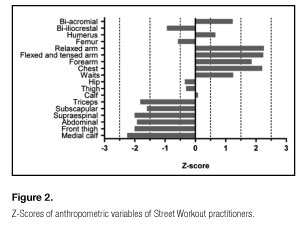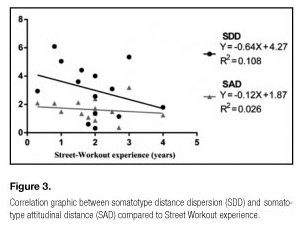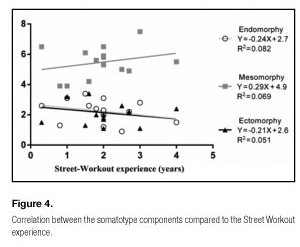Mi SciELO
Servicios Personalizados
Revista
Articulo
Indicadores
-
 Citado por SciELO
Citado por SciELO -
 Accesos
Accesos
Links relacionados
-
 Citado por Google
Citado por Google -
 Similares en
SciELO
Similares en
SciELO -
 Similares en Google
Similares en Google
Compartir
Nutrición Hospitalaria
versión On-line ISSN 1699-5198versión impresa ISSN 0212-1611
Nutr. Hosp. vol.34 no.1 Madrid ene./feb. 2017
https://dx.doi.org/10.20960/nh.987
TRABAJO ORIGINAL / Valoración nutricional
Morphological characteristics of Street Workout practitioners
Características morfológicas de practicantes de street workout
Javier Sanchez-Martinez1, Paula Plaza2,3, Alberto Araneda4, Patricio Sánchez4 and Atilio Almagiâ1
1Laboratorio de Antropología Física y Anatomía Humana. Instituto de Biología. Facultad de Ciencias. Pontificia Universidad Católica de Valparaíso. Chile.
2Escuela de Kinesiología. Facultad de Ciencias de la Rehabilitación. Universidad Andrés Bello. Viña del Mar, Chile.
3Laboratory of Integrative Neuroscience and Cognition. Department of Neuroscience. Georgetown University Medical Center. Washington DC (U.S.A.).
4Escuela de Kinesiología. Facultad de Ciencias. Pontificia Universidad Católica de Valparaíso. Chile
ABSTRACT
Introduction: The determination of the morphological characteristics of the most popular sports has allowed the evaluation and comparison between athletes, which has helped to improve their performance. The Street Workout is an emerging sport based on calisthenics, which recently has become popular. Despite its popularization, neither the morphologic profile nor the morphologic characteristics of Street Workout athletes has been determined.
Objective: Determine the profile and morphological characteristics of Street-Workout athletes, through anthropometry.
Material and methods: Fourteen athletes (22.7 ± 3.26 years) were recruited from the National Calisthenics Tournament 2015 in Chile. The athletes were evaluated following the protocol of the International Society for the Advancement of Kinanthropometry to determine the somatotype, body composition, as well as indices of body composition such as body mass index, waist to hip ratio, waist to height ratio, fat/muscle mass and muscle/bone mass indexes.
Results: Street Workout practitioners presented a balanced-mesomorphic somatotype, a low fat mass and a high muscular development, with upper arms and trunk predominance. Regarding body composition indices, the values obtained allow us to classify them as a low-risk population of chronic non-communicable diseases.Conclusion: The present study sets a first antecedent of the morphological characteristics of Street Workout, determining that the Street Workout athletes presented balanced-mesomorphic somatotype and were classified as a healthy and athletic sample by their body composition indexes.
Key words: Calisthenics. Anthropometry. Somatotype. Body composition. Sport.
RESUMEN
Introducción: la determinación de las características morfológicas de los deportes más populares ha permitido la evaluación y comparación entre los atletas, lo que ha contribuido a mejorar su rendimiento. El street workout (ejercicio callejero) es un deporte emergente basado en ejercicios de calistenia, el cual ha ido ganando popularidad en los últimos años. A pesar de su masificación, aún no ha sido determinado el perfil morfológico ni las características morfológicas de los atletas de street workout.
Objetivo: determinar las características y el perfil morfológico de los atletas de street workout mediante antropometría.
Material y métodos: catorce atletas (22,7 ± 3,26 años de edad promedio) fueron reclutados del Torneo Nacional de Calistenia del año 2015 en Chile. Los atletas fueron evaluados siguiendo el protocolo de la Sociedad Internacional para el Avance de la Kineantropometría para determinar el somatotipo, la composición corporal, así como también índices de composición corporal tales como el índice de masa corporal, cintura/cadera, cintura/talla masa grasa/músculo y músculo/masa ósea.
Resultados: los atletas de street workout evaluados presentaron un somatotipo mesomórfico balanceado, una baja masa grasa y un alto desarrollo muscular, con dominancia en miembros superiores y tronco. Respecto a los índices de composición corporal, los valores obtenidos permiten clasificar a este grupo de atletas como una población de bajo riesgo de enfermedades crónicas no transmisibles.
Conclusión: el presente estudio sienta el primer antecedente de las características morfológicas del street workout, estableciendo que los atletas evaluados presentan un somatotipo mesomórfico equilibrado, siendo clasificados como una muestra atlética y saludable por sus índices de composición corporal.
Palabras clave: Calistenia. Antropometría. Somatotipo. Composición corporal. Deporte.
Introduction
In sports, many efforts have been focused to improve sport performance. Body composition and somatotype determination (Heath and Carter, 1990) have been used to establish specific morphologic characteristics for each sport, which allows to assessment and comparison between athletes within their own sport reference. Through the last years, the specific morph structure of well-known sports like soccer (1), gymnastics (2) or baseball (3) have been established, but in emerging disciplines such as Street Workout -which is based on calisthenics- its specific morphological characteristics have not been defined yet.
Calisthenics is a sports discipline that has been practiced since the ancient Greeks. The word "calisthenics" is composed of kallo and sthenos, meaning beauty and strength, based on the use of the practitioner's own body weight as resistance training (4-7). Currently, this way of training has become popular for the physical preparation of athletes such as gymnastics (5), as well as amongst the military population (5,7,8). In the clinical area, calisthenics has also been used, becoming the most common way of strengthening via physical therapy in the United States (9), while bodyweight training has been considered the number one world fitness trend in 2015 (6).
Nowadays, Street-Workout is a variant of calisthenics. Being an urban discipline, Street Workout is very dynamic, with a strong street essence. This discipline has become popular largely because it does not require special implementations. It is accessible to everyone, and has no cost except the time and passion invested in training (4-7). This sudden popularity has led to the creation of international organizations such as World Street Workout & Calisthenics Federation (WSWCF), founded in Latvia in 2011.
Street-Workout uses one's own bodyweight as resistance for strength training, to improve the execution of pirouettes, spins and combinations on the bars while also allowing the maintenance of difficult postures similar to those that originated in artistic gymnastics, (e.g. the front-lever or straddle planche), as well as postures that are typical of this discipline such as the human-flag (10). Thus, mainly through closed kinetic chain exercises (5) on rings, bars, parallel bars, or the floor, the body is exercised in an integral form, defying gravity through the biomechanics and imagination of its practitioners.
This study aimed to assess the morphological characteristics of Street Workout practitioners due to the lack of knowledge surrounding urban discipline practitioners' morphology.
Methods and materials
This research was conducted according to the principles of the Declaration of Helsinki.
PARTICIPANTS
The sample was composed of 14 volunteers from a total of 60 participants from the National Tournament of Calisthenics 2015, held on January 17th and 18th. All volunteers were male Street Workout practitioners, with the mean age of 22.7 ± 3.26 years and the mean practice-experience was 1.94 ± 0.94 years. All volunteers signed an informed consent form and had reported no injury or sickness.
DATA COLLECTION
It was applied the protocol of the International Society for the Advancement of Kinanthropometry (ISAK), comprising of 21 measurements, including: body mass (using a weighting machine Beurer BF 100®, 100 g precision), body size, 4 diameters (using a Rosscraft anthropometer), 9 perimeters (using a metal Lufkin tape) and 6 skinfolds (using a calliper Slim Guide). Measurements were carried out by ISAK anthropometrists, certified and accredited by the Laboratory of Physical Anthropology and Human Anatomy of the sponsoring university. The procedure was performed during the days of competition, approximately two hours after the athletes' participation, with as little clothing as possible to facilitate the marking and measurement in a proper evaluation room.
DATA ANALYSIS
Somatotype of the subjects was determined by the Heath & Carter method (1990). Somatotype distance dispersion (SDD) and Somatotype attitudinal distance (SAD) of each participant compared to the mean value of the sample were calculated. The somatotype dispersion index (SDI), and Somatotype attitudinal mean (SAM) (Carter & Honeyman, 1990; Carter, 2002) were used to assess the sample homogeneity. Body composition was estimated by Ross and Kerr equations (1993), and fat and muscle mass values, and fat/muscle mass and muscle/bone mass indexes were classified according to Biosystem Argentina Laboratory values. For the method of proportionality, the Z-scores of the Phantom model (Ross and Wilson, 1974) were used, which adjusts and scales anthropometric variables for comparisons between samples or populations. Finally, body composition indexes as Body mass index (BMI) and Waist to hip ratio (WHR) were analyzed using the World Health Organization (WHO) reference values; while Waist to height ratio (WtHR) was analyzed using reference values from the same country of the participants (11).
STATISTICAL ANALYSIS
Data was collected in a 2007 Microsoft Excel form, where basic statistics were utilized such as mean and standard deviation. A greater or equal value of 2 was considered a significant difference of SDI. SAM value was assessed as recommended by Carter (1997): elevated distance (SAM ≥ 1.0); moderate distance (SAM = 0.80 to 0.99); and reduced distance (SAM ≤ 0.79). All values presented in the text and tables were expressed as mean ± standard deviation.
Results
ANTHROPOMETRIC CHARACTERISTICS OF STREET WORKOUT PRACTITIONERS
The mean values of the anthropometric variables and the Z-scores of competitive Street Workout practitioners were summarized in table I. It is worth mention that all sample study variables showed a normal distribution.
The mean somatotype of the Street Workout practitioners was balanced-mesomorphic, scoring [2.2-5.5-2.2] for endomorphy, mesomorphy and ectomorphy respectively. This means that this group of athletes has a greater musculoskeletal development, and low (and equivalent) adiposity and linearity components. However, although the individual somatotype of most practitioners tends towards the mesomorphic component (Fig. 1), a considerable dispersion is observed, determined by the area which the subjects are distributed in the somatochart. The SDI and SAM values, which assessed the homogeneity of the sample somatotype compared to the average, were 3.03 and 1.63 respectively, which is considered a heterogeneous sample by both equations.
Results related to body composition, the subjects of this urban discipline presented a mean fat mass value of 13.65 kg, which is classified as good; while the mean muscle mass value was 35.35 kg, which is categorized as excellent.
ANTHROPOMETRIC PROPORTIONALITY OF STREET WORKOUT PRACTITIONERS
The results of anthropometric measurements as breadth, girth, and skinfolds are presented in relation to Z-score obtained (Fig. 2). Street-Workout practitioners have presented positive Z-scores in shoulder and elbow breadths, while negative values were observed in bi-iliocrestal and knee diameters. The same trend is observed in girths, where negative Z-scores were obtained in the lower body (with the exception of calf perimeter, with a value close to Z = 0), and positive values were obtained in the upper body and trunk. These findings suggest that these athletes have a greater upper body and trunk musculoskeletal development in comparison to pelvic and lower body. Finally, Street Workout practitioners have presented negatives Z-scores (close to -2 units) in all skinfolds, showing a low component of subcutaneous adipose tissue.
BODY COMPOSITION INDEXES OF STREET WORKOUT PRACTITIONERS
The mean fat/muscle mass index (0.39 ± 0.07) and the mean muscle/bone index (4.61 ± 0.52) were both classified as excellent by the Biosystem Argentina Laboratory values. The mean value of BMI was 22.77 ± 1.75, considered normal weight according to the WHO values. The WHR -which is associated with risk of cardiovascular disease, stroke and type II diabetes- has obtained a mean value of 0.83 ± 0.03, which is classified as moderate risk by the WHO values. Meanwhile, WtHR -which quantifies cardiovascular and obesity risk- displays an average of 0.45 ± 0.02, which is categorized as minimal cardiovascular and mortality risk.
RELATION BETWEEN ANTHROPOMETRIC AND STREET WORKOUT EXPERIENCE
When relating SDD and SAD of each Street Workout practitioner to their own practice experience (Fig. 3), a low Pearson correlation value is obtained (r = -0.33 and r = -0.16, respectively). A trend of somatotype "specialization" can be observed by decreasing the dispersion of subjects, as they take longer practicing this discipline.
Figure 4 shows the relationship between each component of somatotype and time practicing Street Workout. A low Pearson correlation value was obtained when linking endomorphy (r = -0.28), mesomorphy (r = 0.27), and ectomorphy (r = -0.23) to the practitioner's experience. A trend of increasing mesomorphy and reduced endo and ectomorphy has been observed.
Discussion
The purpose of this study was to determine the morphological characteristics of Street Workout practitioners due to the lack of knowledge surrounding urban discipline practitioners' morphology. The Street Workout practitioners could be classified as a healthy and athletic sample by their morphological characteristics.
ANTHROPOMETRIC CHARACTERISTICS OF STREET WORKOUT PRACTITIONERS
The mean somatotype of Street-Workout practitioners was balanced-mesomorphic, which is similar to elite gymnasts (2). However, gymnasts have a greater mesomorphic component, and lower endomorphic and ectomoprhic values compared to Street Workout practitioners. This similarity in somatotype could be explained by the common biomechanical demands between these two sport disciplines. Respecting the somatotype dispersion, the sample was heterogeneous according to the SDI and SAM values, which can be attributed to several factors. First, the street component of this discipline results in a non-standardized, self-training, eliciting a certain degree of morphologic diversity. Another factor that could account for heterogeneity of this sample is the wide variety of styles within the Street Workout discipline. Freestyle is well-known, which emphasizes combinations and pirouettes on the parallel bar or high bar in gymnastics. Another style is centered on high muscular solicitation exercises such as those performed with Olympic rings or body postures (front-lever, human flag, or L-sit). A third style within this sport discipline is a combination of both styles.As it was previously mentioned, the Street Workout is an emerging sport discipline, and the low experience of the Street Workout practitioners observed could be another argument of the founded heterogeneity. The discipline's adolescence could have an influence on the level of specialization or ideal body maturation. This could be confirmed in figure 3, where increasing experience relates to the lowest dispersion, leading to increasing sample homogeneity. In addition, the high standard deviation of experience (close to 1 year) could be another factor for the heterogeneity of the sample, as 4 years was the maximum experience and 4 months the minimum. Thus, the high variance of experience in this discipline implies differences in the modulation of body components of the subjects. Taken together, these findings suggest that there is a tendency for somatotype specialization to trend towards a high mesomorphic component and a low endomorphic and ectomorphic component. This tendency emphasizes the balanced-mesomorphic classification in the function of increased practice time, as observed in figure 4.
Interestingly, the individual with lesser Street Workout experience is representative of the sample, representing the balanced-mesomorphic somatotype. There are two possible reasons for this early stage somatotype:
-Four months of Street Workout training is sufficient to shape the body to a balanced-mesomorphic classification. This argument is supported by studies where it was shown that 4-5 months of training were enough to generate body composition changes (12,13).
-This individual could be balanced-mesomorphic before beginning Street Workout practice. This argument is in line with the close relationship between morphology and function, where a balanced-mesomorphic somatotype facilitates the Street Workout practice, acting as a natural selector for its followers. It is worth mention that neither argument is exclusive of the other and future cohort studies, including pre and post measurements of a Street Workout program based on calisthenics are needed to elucidate the influence of this discipline in morphology.
The Street Workout practitioners showed similar values of muscle, bone and fat mass to elite gymnasts using anthropometry (2). This suggests that the practice of this urban discipline generates high fat-free mass and low fat mass levels, same as elite athletes. Previous studies have reported that bodyweight training produces muscle mass and power gains in the upper body, as well as core stabilization and strengthening (5,7,14). The low sum-6-skinfolds and fat mass values could be due to high-intensity intermittent exercises (also known as high-intensity interval training) used in Street Workout practice, which is related to aerobic and anaerobic metabolism (15). The effectiveness of high-intensity intermittent training to promote fat metabolism has been shown by 4-week training programs (8,16). In this way, the potentiality of this discipline is remarkably beneficial; its versatility could be a great contribution towards treating people who have postural alterations, metabolic risks, as well as old people, where exercise based on calisthenics would increase muscle protein synthesis and bone mineralization, reducing muscle deterioration by sarcopenia and preventing osteoporosis and fractures.
ANTHROPOMETRIC PROPORTIONALITY COMPARISON BETWEEN STREET WORKOUT PRACTITIONERS AND ELITE GYMNASTS
Street Workout practitioners present greater development of the upper body and trunk (positive Z-scores) in comparison to the lower body (negative Z-scores). Same pattern was described in elite gymnasts (2), and may be related to the common biomechanical demands where use of the upper body and trunk predominates. However, a difference was observed in humeral and femoral diameters. Gymnasts presented 1.5 and 1.0 units over than Street Workout practitioners, respectively. The competitive differences between this emerging sport discipline to gymnastics, which is an Olympic and professional activity should be emphasized. In addition, elite gymnasts have at least 10 years of training experience 2), starting at about 12 years old (a decisive period in body maturation), where the ability to generate morphological adaptations of the skeletal system influenced by mechanical and hormonal factors is favored (17). In the Street Workout counterpart, the subjects measured in this study had a mean training experience of 2 years and a mean starting age of 20 years. At this age, bone maturation is practically consolidated (17), and could explain diameter differences found. In this way, the question arises whether the practice of Street Workout at an earlier age could generate a closer skeletal development to gymnasts. This fundamental question could be elucidated assessing skeletal development in children who practice this discipline, which is feasible due to the increased early initiation of Street Workout in schools and parks. Street Workout practitioners presented similar in breadths and skinfolds Z-scores compared to elite gymnasts (2). However, the sum of 6 skinfolds has a difference of 19.48% (7.89 mm) compared to the reported value in elite gymnasts (2). The mentioned above, highlights the contrast between professionalism and amateurism in relation to subcutaneous adipose tissue (1).
BODY COMPOSITION INDEXES OF STREET WORKOUT PRACTITIONERS
The sample has obtained healthy values of BMI and WtHR, but a moderate risk value in WHR. The low value and Z-score of hip girth could explain the risk level found in WHR. On this, we suggest the use of WtHR in sports where the development of upper body and trunk predominates in comparison to the lower body, in order to avoid wrong interpretations of cardiovascular pathology and obesity risks. In this way, the practice of Street Workout could generate beneficial factors in protecting against cardiovascular diseases, obesity and mortality, due to the body composition indexes, as well as the high muscle mass and low fat mass observed (18). Thus, Street Workout could help to decrease the upward trend in body fat and blood pressure in young students (19), as well as the overweight and obesity tendency in the population (20). Possible limitations of the current study were the small sample size due to limited voluntary participation The generalizability of our findings is also unknown because the limited number of subjects. About the moment of measurement, it should be done before physical activity as recommendation by the ISAK protocol, but this study took advantage of a unique instance to assess the participants of the National Tournament of Calisthenics.
Conclusion
The Street Workout practitioners could be classified as a healthy and athletic sample by their anthropometric profile. Thus, to our knowledge, the present study sets a first precedent of the morphological characteristics of this emergent sport, which has a great public health potential in promoting physical activity. Because of its accessibility and low cost, its popularity becomes increasingly feasible, which would generate health benefits, such as reducing physical inactivity, obesity, and could consequently help to reduce cardiovascular risk factors and help in maintaining a healthy lifestyle.
Acknowledgements
The authors thank Calistenia Viña del Mar Club, Municipality of Viña del Mar, and the 2015 National Tournament of Calisthenics participants, for their collaboration in this study and support to the development of emergent sport disciplines. We also want to thank the Laboratory of Physical Anthropology and Human Anatomy, Institute of Biology and Science Faculty, as well as the Vice-Rectory for Research and Advancement Studies of the sponsoring university, for its continued support in research.
References
1. Almagia A, Araneda A, Sánchez J, et al. Somatotipo y Composición corporal de la selección de fútbol masculino universitario de Chile, Pontificia Universidad Católica de Valparaíso, campeona los años 2012 y 2013. Int J Morphol 2015;33(3):1165-70. [ Links ]
2. Bies ER, Rosa FJB. Estudio morfológico en gimnastas argentinos de alto rendimiento. Revista Brasileira de Cineantropometria & Desempenho Humano 2006;8(4). [ Links ]
3. Clavijo-Redondo AR, Vaquero-Cristóbal R, López-Miñarro PA, et al. Kinanthropometry characteristic of elite baseball players. Nutr Hosp 2016;33(3):629-36. [ Links ]
4. Tomczykowska P. The modern face of calisthenics. Street Workout as a new discipline of sport. J Health Sci 2013;3(11). [ Links ]
5. Harrison JS. Bodyweight training: A return to basics. Strength Con J 2010; 32(2):52-5. [ Links ]
6. Thompson WR. Worldwide survey of fitness trends for 2015: what's driving the market. ACSMS Health Fit J 2014;18(6):8-17. [ Links ]
7. Del Río R, Díaz A. Calistenia: volviendo a los orígenes. Revista Digital de Educación Física 2015;(33):87-96. [ Links ]
8. Gist NH, Freese EC, Ryan TE, et al. Effects of low-volume, high-intensity whole-body calisthenics on army ROTC cadets. Mil Med 2015;180(5):492-8. [ Links ]
9. Tapley H, Dotson M, Hallila D, et al. Participation in strength training activities among US physical therapists: A nationwide survey. International Journal of Therapy and Rehabilitation 2015;22(2):79-85. [ Links ]
10. Kalym A. Complete Calisthenics. The ultimate guide to bodyweight exercises; 2014. [ Links ]
11. Koch E, Romero T, Manríquez L, et al. Razón cintura-estatura: un mejor predictor antropométrico de riesgo cardiovascular y mortalidad en adultos chilenos. Nomograma diagnóstico utilizado en el Proyecto San Francisco. Rev Chi Cardiol 2008;27(1):23-35. [ Links ]
12. Casajús J. Seasonal Variation in fitness variables in professional soccer players. J Sports Med Phys Fitness 2001;41(4):463-9. [ Links ]
13. Alburquerque F, Sánchez F, Prieto J, et al. Kinanthropometric assessment of a football team over one season. Eur J Anat 2005;9(1):17-22. [ Links ]
14. Kwon YJ, Park SJ, Jefferson J, et al. The effect of open and closed kinetic chain exercises on dynamic balance ability of normal healthy adults. J Phys Ther Sci 2013;25(6):671-4. [ Links ]
15. Boutcher SH. High-intensity intermittent exercise and fat loss. Journal of Obesity 2011;2011: ID 868305. [ Links ]
16. Viñuela M, Vera A, Colomer D, et al. Effect of 12 sessions of high-intensity interval training on body composition in young adults. Nutr Hosp 2016; 33(3):637-43. [ Links ]
17. Rodríguez MH. Pediatría. Madrid: Ediciones Díaz de Santos; 1994. [ Links ]
18. Relation of Muscle Mass and Fat Mass to Cardiovascular Disease Mortality. The American Journal of Cardiology 2016;117(8):1355-60. [ Links ]
19. Contreras-Mellado V, Vilchez-Avaca C, Gómez-Campos R, et al. Trends to Increased Body Fat and Blood Pressure of University Students in Two Cohorts (2009-2014). Nutr Hosp 2015;32(6):2551-8. [ Links ]
20. Williams EP, Mesidor M, Winters K, et al. Overweight and Obesity: Prevalence, Consequences, and Causes of a Growing Public Health Problem. Current obesity reports 2015;4(3):363-70. [ Links ]
![]() Correspondence:
Correspondence:
Javier Sanchez-Martinez.
Pontificia Universidad Católica de Valparaíso.
Brasil 2950.
Valparaíso, Región de Valparaíso.
Chile
e-mail: j.sanchez@outlook.cl
Received: 06/07/2016
Accepted: 12/11/2016


















